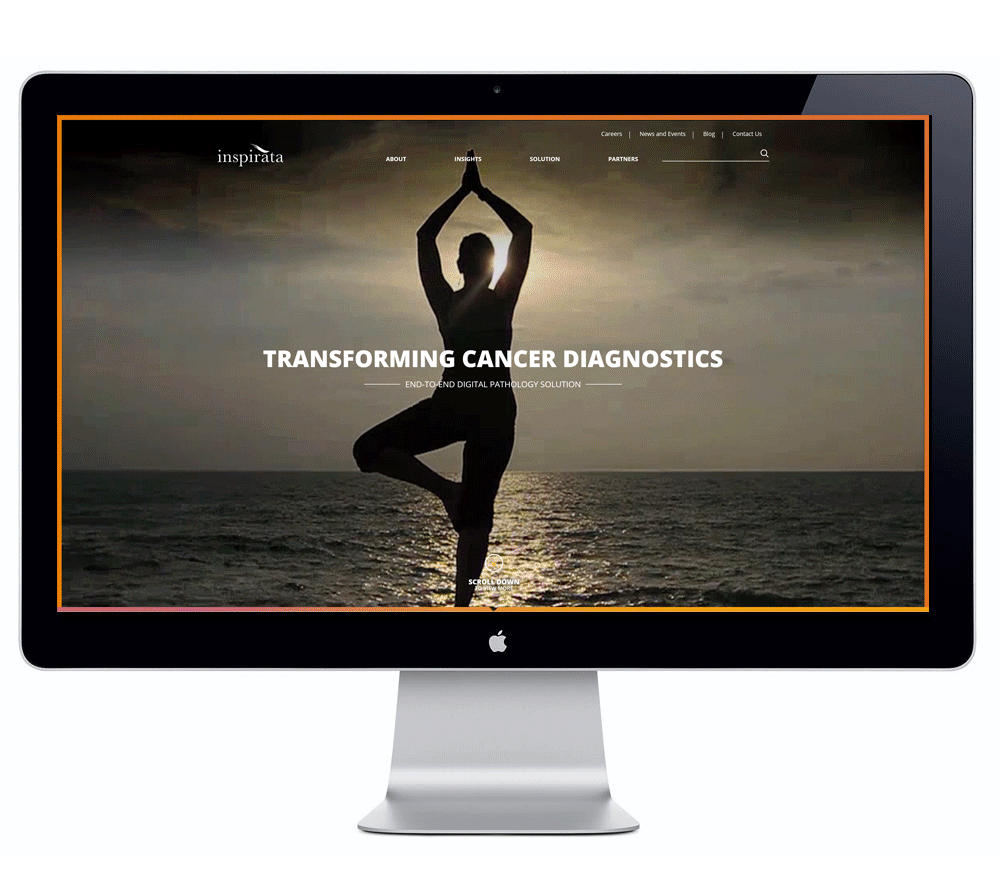When it comes to marketing and communications, government contractors and public sector IT providers face a set of unique challenges. For one, the customer base of Federal, state and local decision makers responsible for purchasing technology products and services – ranging from CIOs and CTOs to program managers, IT managers and procurement officers –represents a finite group that can be difficult to reach.
Compounding this predicament is the fact that government contractors must not only market their brand, product and services to these decision makers, but also time these marketing efforts strategically. This means building awareness far enough in advance of a contract award, and then sustaining marketing and PR efforts throughout what can be a multi-year process from pre-RFP to the contract award – and even beyond due to potential contract protests, delays and budgetary obstacles.
Marketing to agency decision makers is just one piece of the puzzle. For small to mid-sized contractors, marketing and public relations efforts must often extend to larger prime contractors in order to ensure these lesser-known firms are on the radar when Primes are assembling teams to pursue contracts. Large contractors, for their part, must also market needs and capabilities to smaller partners that might hold an elusive product/service, market expertise, status or agency relationship.
We have assembled 6 ways that forward-thinking contractors and IT providers can grow their business and contract opportunities by looking beyond traditional marketing, advertising and public relations tactics.
Leverage B2G responsive landing pages
Responsive design is a critical website approach for providing customers with a seamless experience across all device sizes. With a responsive website, government contractors and IT providers can be in front of buyers at every step of their online journey. A user viewing a website on the go via a mobile device can have the same powerful experience as when sitting in their office.
Responsive websites provide continuity between different viewing contexts, remaining completely agnostic to the type of device used and the size of the screen the user has. Responsive websites also rank higher in search engines’ rankings, as Google recommends responsive web design because having a single URL for desktop and mobile sites makes it easier for Google to discover content and for Google’s algorithms – which are constantly changing – to assign indexing properties to content.
It was the need for a responsive website that brought GovDelivery, which enables public sector organizations to connect with more people and to get those people to act, to Bluetext.
As the number one referrer of traffic to hundreds of government websites, including IRS.gov, SBA.gov, FEMA.gov, IN.gov, and BART.gov, the GovDelivery Communications Cloud is an enterprise-class, cloud-based platform that allows government organizations to create and send billions of messages to more than 60 million people around the world. Bluetext was hired by GovDelivery to help them reach public sector organizations that can benefit with tremendous cost savings while reaching more people, automating complex communications and driving mission value through deeper engagement with the public.
For this responsive design project, Bluetext conceived and designed a responsive landing page with an infographic demonstrating the benefits of using GovDelivery for government agencies as the centerpiece of the campaign. We also developed a responsive email template and infographic poster to be used across many marketing channels.
Extend reach and share budget with B2G partner campaigns
While going it alone from a marketing and public relations perspective provides a company with more control over a campaign, it also can be costly and restrict the reach and impact that could otherwise be achieved by aligning in an innovative way with industry partners.
Bluetext has worked on numerous occasions with industry partners that align around a specific campaign targeting government decision makers. Govplace, a leading enterprise IT solutions provider exclusively to the public sector, turned to Bluetext to develop FedInnovation, a destination designed to help government agency executives get the latest information on current technology challenges and solutions for big data, cloud, security, mobility and storage. Developed in conjunction with leading technology providers including Dell, Intel Security and VMWare, it includes exclusive content, videos, blogs, and real-time social feeds.
FedInnovation combines relevant, fresh content, complementary offers, and financial resources to deliver an educational platform to drive awareness and leads for Govplace across its target market. The development of platforms is a continued focus for Bluetext as we look to conceptualize, design and develop creative solutions that deliver measurable business impact for our clients. It is increasingly clear that customers of our clients demand unique experiences with premium content delivered in an easy to consume manner.
Another partner campaign targeting U.S. public sector executed by Bluetext was FutureAgency.com, a digital content experience effort on behalf of McAfee and Intel that depicted virtually a “future government agency.” For this project, Bluetext created a virtual experience around client subject matter experts in an effort to present content for government decision makers in a more engaging fashion. Rather than static white papers and marketing slicks that often go unread or unfinished, Bluetext created an experience whereby avatars of actual company thought leaders were created, and they delivered presentations on topics in a virtual conference environment. The clients found length and quality of site visitor engagement superior to that of traditional white papers and similar content.
Create compelling B2G digital experiences to reach decision makers
The web has become a go-to resource for decision makers to research products and services prior to purchase. Product sheets, white papers and other pieces of online collateral can be useful supporting resources for government decision makers, but will hardly help contractors stand out in a crowded marketplace.
Recognizing this, government contractors and IT providers are creating more dynamic, immersive digital experiences that can more effectively engage target constituencies and impact the decision making process. Additionally, these experiences are molded to be as valuable as any in-person interaction site visitors would have with products and services.
A recent Bluetext project showcases a forward-thinking technology provider, CSC, which was seeking to ensure prospective customers could have a similar experience as they would if they were physically at CSC’s corporate headquarters.
Bluetext designed and built CSC’s Digital Briefing Center, a virtual experience where clients and CSC’s entire ecosystem can come to learn about CSC’s key technology conversations across its target verticals.
Bluetext designed a virtual office building where each floor represents a specific vertical industry, and visitors can learn about CSC’s key solutions and experience across cloud computing, big data, applications, cyber security, and mobility. While not specific to the government market, it is indicative of how “stickier” digital experiences are reshaping how existing and prospective customers interact with content.
Highlight customer innovation
No matter how large or well-known a government contractor/Federal IT provider is, gaining approval from an agency to speak publicly about a technology project is often mission impossible. Agencies must be careful not to appear to endorse a specific vendor in public comments or a press release quote, and even when project leaders are amenable, the process often grinds to a halt with the more conservative public affairs officers.
As such, vendors often have their hands tied on how to showcase a successful project so that other agencies – or even other decision makers within the same agency – will take notice. An approach that can bear more fruit involves shining the spotlight on an agency leader or the agency itself through awards and speaking opportunities.
Multiple editorial publications and associations hold annual award programs that showcase outstanding IT projects and agency leaders at the federal, state and local government level. Agencies tend to be more open to sharing an IT story through an award because it demonstrates innovation and can assist with employee morale and retention.
Beyond award programs, there is also significant benefit in generating media coverage and awareness of state & local customer projects. These agency customers tend to be more amenable to participating in public relations campaigns, and the drawing attention to these projects can demonstrate capabilities to prospective Federal customers as well.
Develop targeted B2G campaign to pursue a specific contract
As contractors and IT providers know all too well, winning an agency contract requires a very different sales cycle than a small business user signing up online for Dropbox or a similar “as-a-Service” software offering.
At some level, there will always be marketing activities designed to reach decision-makers across multiple civilian or military agencies – and in some cases both segments. These external efforts may involve communicating product capabilities, service chops, or the expertise of the contractor’s team. But in today’s hyper-competitive market for agency contracts, developing innovative, targeted campaigns in pursuit of a specific contract or that are designed to reach decision makers at a particular agency, can make the difference between a game-changing contract win and a devastating loss.
Bluetext is increasingly tasked to partner with contractors in developing innovative branding and outreach campaigns around a specific contract pursuit. In early 2014, L-3 Communications, in partnership with Harris Corporation, hired Bluetext to help them pursue the Air Force’s $1B Satellite Control Network (AFSCN) Modifications, Maintenance & Operations (CAMMO) Contract.
Bluetext worked with the L-3/Harris Capture teams to develop a campaign strategy that would position them as a Prime by highlighting the many advantages they bring to the table. The overarching campaign theme Bluetext developed is:
“The Power of Partnership, From Vision to Reality”
The creative strategy of this project began with the core concept of the ad, “from vision to reality.” The left side of the ad is a wireframe representing the vision with the right side representing its reality. After the wireframe of the satellite was created, it was overlaid on top of the red diagonal to create a striking visual element to draw attention to the campaign. The first series of ads were placed in high visibility areas inside of Colorado Springs Airport, a key travel hub for Air Force brass. The media plan for the campaign also includes online, print and OOH media placed strategically to maximize reach and frequency throughout the entire contract RFP and award lifecycle.
Focus on agency challenge, not yourself
Dramatic changes in staffing and mission of government IT media outlets means that the days of getting a product reviewed or corporate profile written are for the most part a thing of the past. As such, contracts and IT providers must get far more creative when it comes to communicating capabilities.
Government IT press don’t want to hear about products. They want to hear about trends and challenges sweeping through agencies, and how contractors and IT providers are developing solutions to solve those challenges.
This was the backdrop for a media strategy Bluetext architected for Adobe Government. Over the past few years, government-wide budget cuts have been swift and relatively unsparing in their impact on agency in-person conferences and training events. This presented a significant challenge for agencies seeking to maintain the collaboration and education benefits these events delivered.
The challenge dovetailed with Adobe’s web conferencing solution Adobe Connect, which was seeing a rise in demand in the public sector due to pullbacks in physical, in-person conferences. Bluetext built a PR campaign around this angle that included a pair of thought leadership articles (one targeting the broad federal IT community and one targeting military decision makers), generating multiple articles around this topic in key federal, state and local media outlets, including:
Federal Computer Week – Budget cuts push conferences online
Washington Technology – Budget cuts, scandal fuel videoconferencing boom
Federal Computer Week – Could virtual meetings replace conferences in sequestration age?
Defense News – Communicating in an era of canceled conferences
Federal Computer Week – Defense Connect Online hits milestone
State Tech – Mobile Video Conferencing Powers Collaboration on the Go
Federal Computer Week – DOD connects online to cut travel
Government Executive/NextGov – Agencies are saving millions with virtual events
Federal Computer Week – Cutting costs with virtual conferencing
Reaching and impacting government decision makers requires government contractors and IT providers to push beyond the status quo and engage with partners able to help develop and deliver innovative campaigns to grow their business and increase contract opportunities.
A dynamic logo is a company mark that is malleable and constantly changing while maintaining its overall look and feel. Logos were once thought of as a permanent visual representation of a company, but in the ever-changing digital world that is no longer the case. Here is what you need to know about dynamic logos.
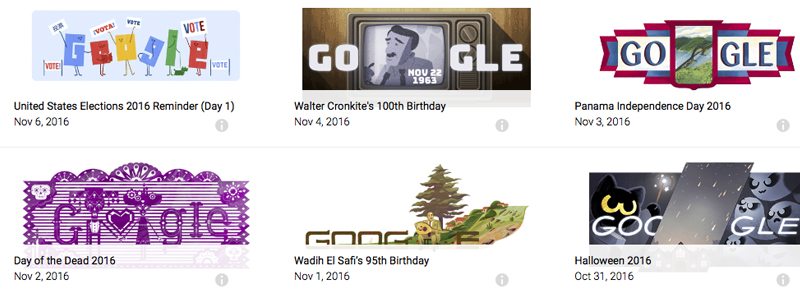
Logos are no longer static and evolve with the brand. The company mark is now transformative and many companies, such as Google, have begun consistently changing the display of their mark. The challenge is to maintain a consistent visual identity in the logo so the brand is still recognizable to consumers. This involves certain visuals of the logo to remain locked, while other elements are consistently inconsistent.
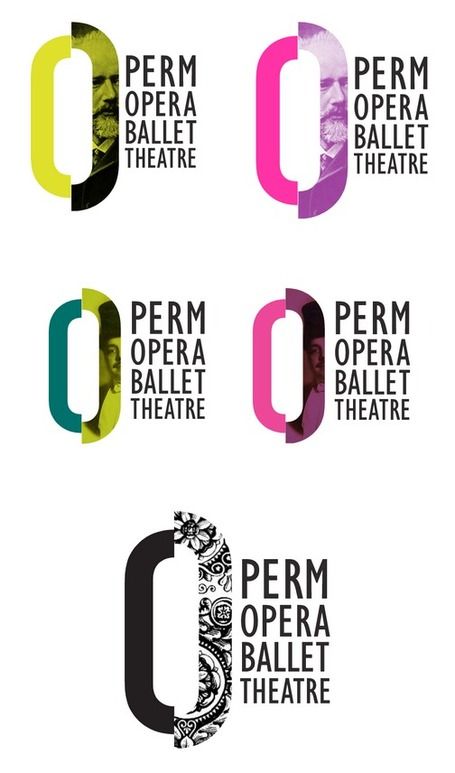
Many well-known companies have enlisted the aid of top branding agencies to shift towards dynamic logos, include AOL, MTV, and Seagate. A step further would be an animated logo that is responsive to the consumer. One such logo is the mark of Brazilian communications company, Oi. The company’s type is the fixed visual while splashs of color that shapeshift to the consumer’s voice is infinitely dynamic. With such a dynamic logo taken to the next level, there are now endless versions of the company’s mark unique to its consumers.
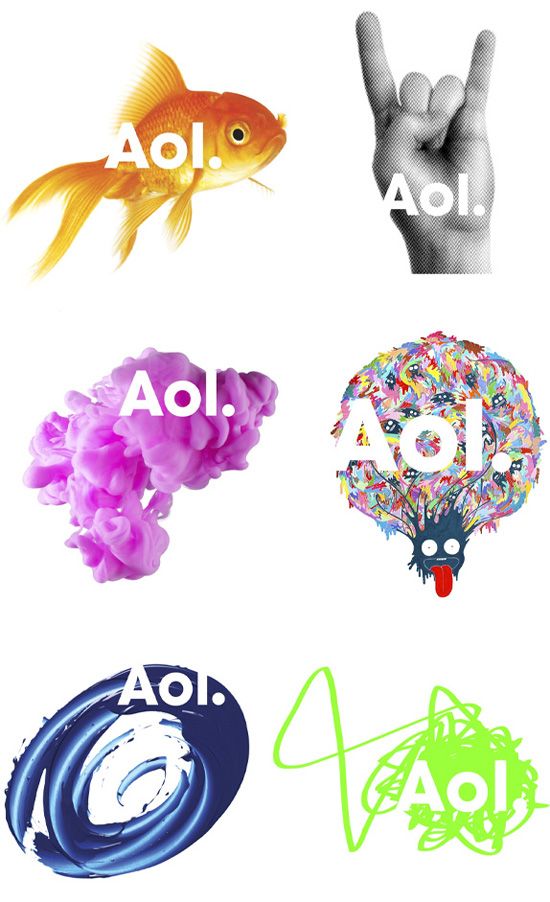
A dynamic logo allows a company to shape the consumer’s experience with its brand. By using these types of brand logos, companies have the fluidity to customize their mark for any occasion and engage their consumers.
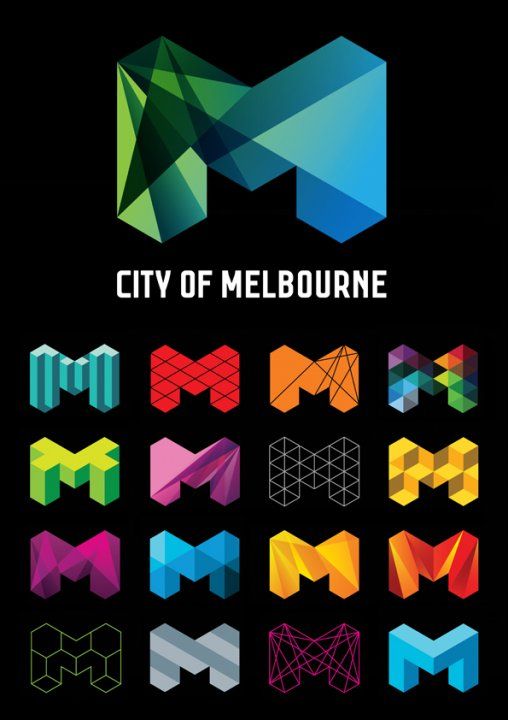
Looking for best in class branding agency services or comprehensive and innovative digital marketing? Contact us.
A logo is a central part of a company’s brand. It’s the first thing customers see, and what they learn to recognize as a short-cut to your brand values. And it needs to convey a strong message about what you stand for, and how you work with your customers. Choosing the right logo can make a big difference. Refreshing your current logo might be even more crucial.
Here are five reasons why companies refresh their logos:
Hindrances. As a company evolves and grows, its products and services will change in tangent. A logo from its past may now risk pigeon-holing and hinder the company’s growth. A company’s original logo may include words describing its offerings. As its product and services expand a logo refresh would be needed to accurately represent its growth.
Modernization. Overtime logo images that were once fashionable can become considerably outdated. Sleek, minimalistic logos are the trend today and many companies find the need to adjust their logo to appeal to today’s audience and stay relevant in the market.
Renaming. When a company changes its name, its original logo may no longer be relevant and a logo refresh is due. This is especially true for companies where their original logo was a literal representation of its original name.
Digitization. As the world grows increasingly digital companies now need to take into consideration how their logo renders on different screen widths and other mediums on the web. Old logos did not take responsiveness into consideration and must redesign and refresh to adapt in the digital age.
Acquisitions. When two companies become one, the company name may change and their logo as well. An acquisition instantly expands a company’s products or service and their original logo may no longer be an accurate representation of the new company.
Since a company’s logo is such a close depiction of a company, a major change in any area of its business will affect its single most important visual representation. A logo refresh aligns a company with its core values and ultimately its consumers.
Looking for best in class digital marketing? Contact us.
As more and more brands enter digital maturity, new top-level domains (TLDs) are becoming available for registration. Previously, only generic domain names and country code domains were available for use, such as .com, .net, .us, .ca, etc. Now the doors have been opened to a whole new set of domain extensions, including .business, .expert, and .guru. Here is everything you need to know about new top-level domain names and why they were introduced:
Growing Shortage of Alternatives. As companies expand their presence in the digital space, acquiring an appropriate top-level domain name has become increasingly difficult. It wasn’t long before most short domains were taken and resulted in newer domain names becoming increasingly long and absurd. For example, flights.com is unavailable and the alternatives becoming increasingly bizarre: cheapflights.com, buycheapflights.com, bestcheapflights747.com.
Providing New Choices. The introduction of new domain name structures not only made it possible for companies to acquire an appropriate domain, but also tailor their domain to appeal to both their target consumers and performance on search engines. For example, healthfoodbusiness.com can now be structured as healthfood.business or health-food.business.
A Domain Name at a Glance. With increased flexibility for companies to acquire a tailored and concise top-level domain, it is possible for consumers to gain more insight about a company directly from their domain name, such as their location and area of business. From a company’s perspective, a differentiated and professional domain name may provide it the edge they need over their competitors.
Increased Regional SEO Value. Search engines currently do not rank new domains differently from established domains on a search engine results page (SERP), but there are regional benefits where a .de domain will rank higher on SERPs in Germany but not in the USA. With this in mind, companies may want to consider how this affects their choice on a top-level domain name if their target audience is in a different region, for example: green-cars.ottawa.
New TLD Name Options. The list of available new domains is growing every day, but in general new domains can be internet terms, a description of an offer, or regions. Examples include: .website, .online, .webpage, .work, .photography, .travel, .ca.us, .berlin.de, .bc.ca, etc. The possibility for a company to acquire a more suitable domain is now significantly higher.
Restrictions on Choosing a New Domain. When a company is choosing a new top-level domain name, it must follow rules set by the respective domain registry. Common restrictions include trademark law and regional domain extensions. Protected company brands and names are not available while many regional domain extensions are only allowed if the company is based in that specific region.
Securing a New TLD Name. While many new domain names have launch dates, many others do not have a specified release date. Companies can either request a non-binding pre-reservation for domains without a specified release date or a binding pre-registration for domain names with a specified release date. Non-binding pre-reservations allow companies to pre-order a new domain name with no obligation to buy when the domain is ultimately released. Binding pre-registrations require payment upfront and is a binding agreement.
The availability of new top-level domain names opens doors for companies seeking to harden their digital presence. Ultimately, the decision to choose a new domain name is a strategic one that should be made in tangent with a company’s business goals. As the world evolves to be increasingly digital, how a company presents itself on the world wide web is more important than ever.
Looking for best in class digital marketing? Contact us.
Rebranding is not to be taken lightly. It demands a commitment of time, energy and resources to be successful. There are many things a company should consider and analyze before the decision to rebrand is made. As the world grows increasingly digital, more and more aspects of people’s lives are affected by the instantaneous nature of information. This needs to factor in to the direction the brand needs to take. The accessibility of information at people’s finger tips has changed the mindset of consumers, posing significant challenges:
Where are your consumers? It is difficult nowadays to find someone who does not own a smartphone with the ability to access the internet anytime and anywhere. As consumers spend more time on smaller screens, companies must optimize all aspects of their websites and platforms to perform on these devices— or risk hurting their brand with hard-to-read and poorly-rendered webpages. Companies either need to rebrand and keep up with the times or risk becoming obsolete.
Are you targeting effectively? With the rise of the digital age is the emergence of social media platforms and numerous new ways for a company to reach the people they would like to target. Each new medium requires a different strategy to navigate and not all companies are equipped to immediately do so. A company’s current messaging and image may not have the ability to capture the attention of its target audience. These obstacles are a clear sign that a company needs to revamp its brand to maintain a strong market presence.
How flexible is your current brand? A company’s graphics and visuals must be scalable and adapt to different mediums. Brand assets in the modern era are used for web, mobile, print assets, social media, icons, and the list goes on. All these elements must be taken into consideration starting at the core of a brand’s design for the company to grow along with its consumer base. When a company is unable to effectively utilize its brand in new mediums, a brand redesign is needed before the company falls too far behind.
As the digital age brings new challenges, it also brings new opportunities. An increasingly responsive world may cause initial difficultly for a company adjusting to adapt, but by rebranding doors are opened for the new brand to reach its target audience like never before.
Looking for agency help? Contact us
Today, a website is the front door to your association, and every effort must be made to deliver a powerful user experience for current and prospective members. Your digital platform must be modern and intuitive. Beyond a great design, it is important to make sure your website is addressing all of your association key performance indicators around member services, member retention, communications, activism, and engagement.
To this end, when thinking about your association’s website, a great design is not necessarily where you should begin. The first question you should ask yourself is, “Is our website working as hard for our association as it can to help us achieve our association goals in the most efficient manner.” Understanding where your members are coming from, how are they accessing the site, and what tools they need to be successful all must be asked up front through a discovery process in order to maximize the impact of a new website.
With that thought process in mind, here are some recommendations to consider when undertaking a new website design for your association:
- Provide the tools and resources to help your members do their jobs more effectively. They are paying you to be their advocates, and they need your help in taking action, remaining relevant, and proving the impact and rationale for their membership. For one membership organization, we built a tool that enabled human resources professionals to directly send a presentation to their bosses to show the value and impact of their membership in that organization. It was a very effective tool for ensuring membership dues.
- Clearly communicate the value and impact you provide. Make sure your messaging and value is clear right up front. We have worked with many associations who are going through an identity crisis and don’t understand why membership may be down or why they are less relevant than in the past. It may be time to audit your messaging and positioning, both internally and externally, to ensure it is relevant to your members and the communities you serve.
- Don’t be afraid to brand with impact. Changing colors or changing logos can go a long way toward sending a powerful signal to your constituencies. And make sure that the design direction you take aligns with that of the industry you serve. If you that’s the tech community, make sure your brand feels techy. If you serve the healthcare community, make sure your brand aligns. You get the picture. Modern, fresh and engaging can really make an impact in the perception of your association as you go to market with a new website.
- Content. Content. Content. Being a thought leader and delivering authoritative content is critical for success. Keep your content fresh and engaging, update it regularly, and address the current and emerging topics that are of importance to you members. Association content marketing is becoming a must for the most advanced associations.
- Make sure your content is Search Engine Optimized and your architecture is designed for SEO best practices. There is so much talk about SEO that people get confused. But that should not be the case. Go analyze what people are searching for and align your content around that. Ranking high with Google and Bing can be very effective.
- Go mobile. Look at your stats. People are accessing the web from mobile devices more than ever and the stats continue to rise. A responsive site is a must in today’s digital environment. If a user does not have a great experience with your association on a mobile device it can impact your value immensely.
Top branding firms focus on a variety of factors when rebranding a company. A brand refresh is a large undertaking that involves individuals at all levels in an organization to successfully implement. With the aid of a branding firm, the process can be smoother than expected. Here are 5 more things top branding firms to consider when rebranding your company:
What is your company’s reputation in the market? A company’s reputation can precede it in the market place and form impressions in the consumer’s mind even before they have exposure with your brand. If your company has less than a positive reputation within the market place, rebranding will provide you the opportunity to start anew with a clean slate.
Are you planning to expand your business abroad? There are many adjustments for a company to take their business into the global markets, and a rebrand may be necessary for a company to ensure they appeal to consumers in the global markets past cultural and social lines. Top branding firms are experts in helping companies navigate this tricky terrain to achieve growth in international business ventures.
Has there been a drastic change in executive leadership? A change in a company’s top leadership positions may cause enough organizational changes that the current brand no longer resonates with the company’s new direction. Rebranding the company becomes necessary for the company to maintain a cohesive voice and image.
Is there the need to further develop a corporate identity? As a company grows and develops overtime, the preliminary guidelines set for the brand at the beginning may no longer be strong enough to define the brand as a whole. Without a standardized visual style or extended color palette for example, the company’s corporate identity quickly becomes muddled. Top branding firms set disciplined brand guidelines to ensure uniformity company wide.
Has there been a change of company ownership? When a merger or acquisition occurs, or if a company shifts from private to pubic, there is the immediate move to rebrand the firm. In the case of a merger or acquisition, rebranding fully integrates the new portions of business under one corporate identity to maintain uniformity in the market. When a company shifts from private to public ownership, the company now must comply with legal requirements and top branding firms can be a key player in aiding this transition.
A brand refresh is more often than not a necessary marketing strategy as a company grows and undergoes changes. Top branding firms aid companies of all industries in making this critical change and continuing achieving success in their respective markets.
Looking for agency help? Contact us
There are many factors top branding agencies focus on when rebranding a company. Typically, companies rebrand every 7-10 years but what motivates them to do so? Rebranding often involves choosing a new standardized color palette, a new logo, a new voice, and even a new name. Company dynamics shift to embody the new image and it can be challenging for everyone involved. Here are the 5 things top branding agencies to consider when rebranding your company:
How does your brand stack up to the competition? When placed next to your competitors, how does your company measure up? Do you appear modern and cutting edge? Or do you appear outdated and in need of an upgrade? Visuals aren’t everything, but the first impression a potential customer has of your brand may be a lasting one and ultimately sway their decision in a saturated marketplace.
Are you reaching your target audience? Companies utilize different strategies to appeal to different consumer groups. What appeals to millennials may not capture the attention of older generations. If your company’s goal is to reposition itself in the marketplace to win over a new consumer base, a brand refresh from a top branding agency may just be what your organization needs to reach its goals.
How are the markets changing? Technological advancements have caused major shifts in many industries that have required companies to adapt quickly. The rapid pace of digitizing society has meant companies need to keep up with the times or find themselves left behind. Top branding agencies specialize in positioning their clients for success by implementing best practices in the digital space.
How has your company grown? As companies evolve and increase the offerings of their goods and services in different sectors of the market, the original brand may no longer resonate with its diversified consumer base. Such disconnect between the brand and its offerings may begin affecting the company’s marketing efforts of outlier products or services. Top branding agencies work with clients in such growth dilemmas to find cohesiveness in their organizations and create a new corporate visual identity to tie everything under one brand.
Are there inconsistencies within your company? Are there many different versions of consumer-facing assets used within the company? Is the company voice disconnected from one product or service to another? Are consumers unaware two of your products or services are offered by the same company? If so, rebranding may be a necessary strategy to help both the consumer and company connect the dots of a fragmented brand.
A company rebrand from a top branding agency is more than just aesthetics. A fresh new look and feel is noticed by consumers and works as a strategy to bring more cohesion to the company while simultaneously drawing attention from the market.
Looking for agency help? Contact us
Brand Strategy
The Message and Brand Story
Rarely do you get a chance to work with a client so convinced that they can change the way cancer is diagnosed and treated that it energizes an entire agency. That was the case with Inspirata. After spending five minutes with founder Satish Sanan, it became clear that he had the resources, vision, and passion to shift an entire industry. With significant backing from major investors including the founder of NetJets, Satish came to Bluetext to launch a brand in a very short time. He wanted to focus on building and executing the business and asked us to develop a name, logo, messaging, website, brand story, process and video. The Bluetext team was up to the challenge.

The Name
Creating a name across the medical informatics industry is a challenge as every great idea seems to be taken. But after an extensive messaging process and a team that was open to exploring many possibilities, we came up with this concept of Inspirata, meaning inspiring data. By digitizing the entire pathology workflow process, Inspirata is focused on transforming cancer diagnostics and driving better patient outcomes for people across the globe. They are focused on inspiring a market and everyone fell in love with the name Inspirata.
Brand Presentation
The Logo
Clean, elegant, professional – that is the hallmark of this brand, and the logo is designed as a simple yet elegant mark that is recognizable but not overpowering.
Corporate Visual Identity
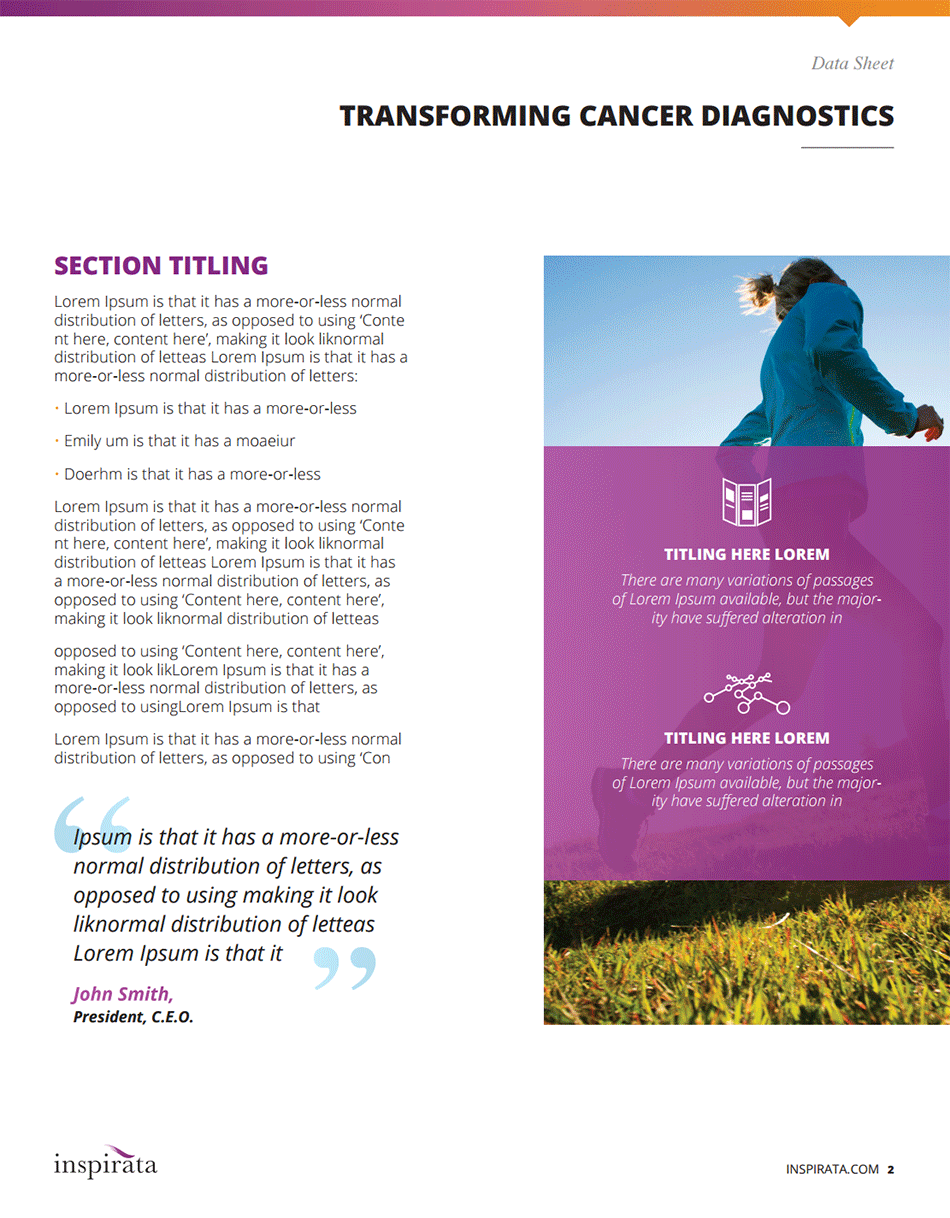
Bluetext designed a corporate visual identity system that aligns perfectly with the brand mission and story. It is simple and elegant but not overpowering.
Website
The centerpiece of the Inspirata brand is a powerful, responsive website designed to be easy to use, easy to navigate, and drive users down a path to understand the vision and mission of Satish and his entire management team. Big bold imagery, vibrant colors and lots of original content are the hallmarks of this powerful website which can be found at www.inspirata.com
Brand Delivery
In advance of the company’s launch at the USCAP 2015 Conference in Boston, Bluetext designed a powerful tradeshow booth to highlight the pathology office the future, designed an interactive infographic which demonstrates the company vision of transforming the case review of the future, and developed, in partnership with Philips, a partnership video to talk about the impact the two companies will have on the global digital pathology market.

In the arena of top marketing firms, data-driven marketing seems like the key buzzword of the past few years. In fact, it’s no passing fade. Leveraging analytics to reach target customers has become a key component of any successful digital campaign. According to a recent survey by the Global Alliance of Data-Driven Marketing Associations, employing a data-driven approach has become the backbone to just about any campaign or messaging—whether it’s targeting the right audience, or even predicting potential success. And as marketing technology continues to make inroads across the industry, it’s should not be surprising that more businesses want to take a data-driven approach to their marketing.
The use of data to improve the effectiveness of marketing, and to measure it, is virtually universal these days. In fact, a recent study found that the number of marketers who still don’t use data are now just one in 10. In addition, even more complex data techniques, such as integration of third-party data and cross-channel measurement, were found to be widely used.
The survey found that more than nearly 80 percent of advertising and marketing professionals are now using data-driven techniques to maintain customer databases, measure campaign results across multiple marketing channels, and segment their data for proper targeting. Again, for those of at the top digital marketing agencies, this finding makes perfect sense. Marketing automation platforms, when configured properly, can easily deliver this type of feedback, and those platforms have been aggressively showcasing these capabilities.
The survey, which targeted both advertising and marketing executives from a wide variety of industries, notes a clear shift in spending patterns. The survey respondents reported a strong expectation that spending on data-driven efforts would continue to rise. Nearly two-thirds of the respondents said their spending on data analytics for marketing would rise, while only seven percent said they expected a decline in spending the coming year.
While data-driven marketing is not quite yet a flawless solution, that’s not unexpected for a relatively new approach that relies on new technologies, data-driven marketing isn’t a perfect solution, at least not yet. A recent analysis from Square Root found a challenge for many companies is gathering the type of high-quality data that is necessary to optimize results. Data analysts are searching to find more effective ways to collect, manage and understand data. Forty-four percent of the survey respondents reported that they were still using outdated tools. A similar amount believed they could make decisions without in-depth data. According to the survey, over a quarter of respondents cited other time wasters from data source overkill to bad numbers. Square Root’s study, in particular, found more than half of data professionals felt they could use better training, closely followed by another 49% who desired more user-friendly or updated data tools.
But chief marketing officers and other executives wouldn’t be making these investments if they didn’t think they deliver results. They recognize the benefits to the bottom line.
